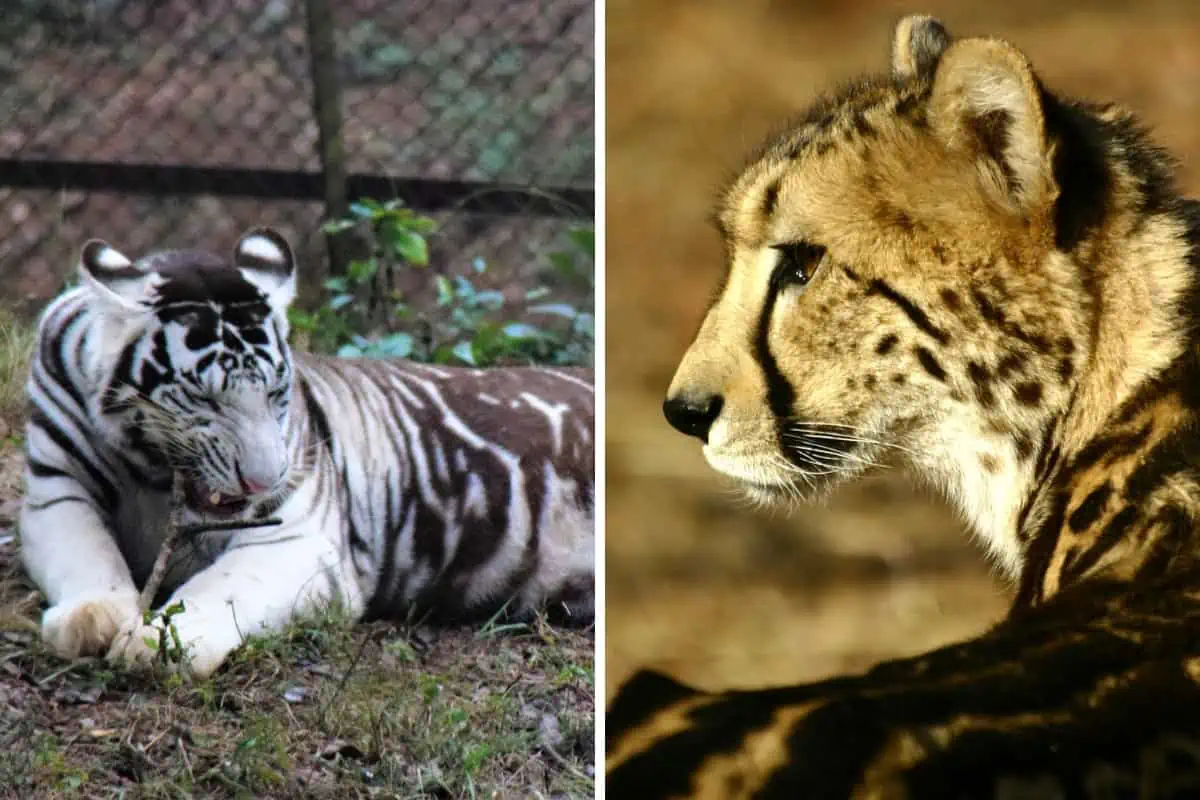The black tiger, a fascinating color variant of the Bengal tiger, known for its pseudo-melanistic appearance, is not a separate species or subspecies but a result of a genetic mutation that has made th ese beautiful creatures even more elusive and captivating.
In this article, I will delve into the secrets of black tigers, exploring their characteristics, rarity, and the efforts needed to conserve these incredible animals for future generations.
10 Facts about the Black Tiger:

1. A Darker Bengal Tiger with Unique Stripe Patterns
A Unique Phenotypic Variation
A black tiger is actually a Bengal tiger with wider and thicker stripes that merge together in certain areas of its body, resulting in a darker appearance.
While the animal’s fur is not truly black, its heavy stripes create the illusion of darkness, earning them the name “black tiger.”
This striking and unique phenotypic variation makes black tigers a subject of great curiosity and admiration among wildlife enthusiasts like myself.

Pseudo-Melanism and Genetic Mutation
The official term for the black tiger’s appearance is pseudo-melanistic, meaning they are not entirely black but appear so due to their heavier stripes.
This intriguing color variation is caused by a genetic mutation that leads to thicker and more pronounced stripes, resulting in the animal’s darker appearance.
This mutation is similar to the one that produces the rare and striking king cheetah, another big cat with an unusual and captivating coat pattern.
2. Compared to Black Panthers and Melanistic Leopards
Sharing the Same Territory
Tigers and leopards often share the same territory in the wild, making it easy for observers to mistake one for the other.
This is especially true regarding black tigers and their melanistic counterparts, black panthers (or melanistic leopards).
The few black tigers in the wild share the same habitat as these other elusive and dark-furred felines, adding to the confusion and mystery surrounding their sightings.
The First Sighting
The first known sighting of a black tiger was described in detail by artist James Forbes, who noted the animal’s conspicuous black stripes against its dark fur.
This description highlights the distinctiveness of the black tiger’s appearance and the potential for confusion with melanistic leopards or black panthers, which are better known for their nearly all-black coats.
3. Lack of Evidence Doesn’t Mean Lack of Existence
A Pseudo Melanistic Appearance
Although black tigers are not as “black” as melanistic leopards or jaguars, their distinctive appearance is still notable and captivating.
They retain the characteristic orange coat of Bengal tigers, but the merging and clumping of their wide stripes create a darker appearance, once again emphasizing their pseudo-melanistic nature.
The Rarity of Black Tigers
The rarity of black tigers may contribute to the lack of evidence for their existence, but that does not mean they do not exist at all.
In fact, their scarcity only adds to the allure and intrigue surrounding these magnificent animals.
Like the more famous white tigers, black tigers are a testament to the incredible diversity and variation within the world of big cats, inspiring awe and wonder among those fortunate enough to catch a glimpse of them in the wild or captivity.
4. Not a Separate Species or Subspecies
A Result of Genetic Mutation
Like the white tiger, the black tiger is not a separate species or subspecies of tiger
Instead, its unique appearance results from a genetic mutation that causes these tigers to have thicker stripes that merge together, creating a blotchy and darker appearance.
This mutation is similar to the one responsible for the king cheetah, another big cat known for its distinct and captivating coat pattern.
Understanding the Genetic Factors
The genetic mutation that leads to the black tiger’s unique appearance is related to the Transmembrane Aminopeptidase Q (Taqpep) gene. This gene plays a crucial role in producing the blotchy, tabby-like patterns seen in other cat species, such as the king cheetah.
By understanding the role of this gene and its alteration, researchers and conservationists can better comprehend the black tiger’s distinctive appearance and work towards preserving its genetic diversity.
5. The Inheritance of the Black Tiger Gene
Both Parents Must Possess the Gene
For a black tiger to be born, both parents must possess the gene responsible for the heavy stripe pattern.
The absence of this gene in one parent significantly diminishes the probability of producing offspring with this unique appearance.
This genetic requirement adds to the rarity of black tigers, making them even more exceptional and precious in the world of big cats.
The Role of Inbreeding
The rarity of black tigers may lead to inbreeding in the wild or captivity, as these animals seek mates with the same genetic makeup.
Inbreeding can result in physical deformities, ailments, and other genetic anomalies, making it crucial for conservationists and researchers to carefully monitor and manage the breeding of these rare animals to ensure their long-term survival.
6. Rarer Than the White Tiger
The Popularity of White Tigers
White tigers have long been considered rare and exotic, drawing large crowds and generating significant profit for zoos and wildlife attractions.
However, the prevalence of white tigers is largely due to rampant inbreeding, driven by the demand for these beautiful animals. This inbreeding has led to numerous health issues and genetic abnormalities within white tiger populations.
The Rarity of Black Tigers
Black tigers are far rarer than their white counterparts, with fewer than a dozen reported black tigers.
As interest in these mysterious animals grows, there is a risk that the same inbreeding practices used to produce white tigers could be applied to black tigers, leading to similar health problems and genetic issues.
It is crucial for conservationists, researchers, and wildlife enthusiasts to work together to protect these rare animals from exploitation and preserve their genetic diversity for future generations.
7. Smaller Than Most Tigers
The Impact of Inbreeding on Size
Sadly, black tigers are often smaller than other tigers due to inbreeding.
This size reduction has been observed in both captive and wild black tigers, illustrating the negative consequences of inbreeding on the health and well-being of these rare animals.
A Small, Isolated Population in India
There is evidence of a small, isolated population of black tigers in India that does not regularly breed with other tigers in its territory.
As a result, these black tigers interbreed and produce offspring with the same unique physical characteristics.
This isolation contributes to the rarity of black tigers and highlights the importance of conservation efforts to protect these animals and their habitats.
8. Black Tigers and King Cheetahs
Shared Genetic Traits
Despite not being of the same species, black tigers and king cheetahs share a surprising connection.
Both animals have a gene alteration in the Transmembrane Aminopeptidase Q (Taqpep) responsible for their unique and blotchy coat patterns.
This shared genetic trait highlights big cats’ fascinating diversity and complexity and showcases the importance of studying these rare animals to understand their genetic makeup better.

The Importance of Genetic Diversity
The connection between black tigers and king cheetahs emphasizes the significance of genetic diversity in the animal kingdom.
By studying these two captivating creatures and their shared genetic traits, researchers can gain valuable insights into the role of genetics in animal appearance and behavior, potentially leading to breakthroughs in conservation and wildlife management efforts.
9. A Spectrum of Color Variations
Three Known Color Variations
The black tiger is just one of three known color variations tigers display. In addition to the well-known white tiger, there is also the golden tiger, which possesses a lighter orange coat.
While these color variants may look strikingly different from one another, they are all part of the Bengal tiger lineage. They are considered phenotypic mutations rather than separate species or subspecies.
A Stripeless Tiger?
There is also a stripeless tiger, which is typically grouped with the white tiger due to the similar genetic mutation responsible for its appearance.
Despite the range of color variations among tigers, they all belong to the same species, emphasizing these magnificent animals’ incredible diversity and adaptability.
10. Conservation and Preservation
An Ultra-Rare and Endangered Animal
If we were to treat black tigers as a separate species or subspecies, they would be considered ultra-rare and endangered.
Considering that tigers are an endangered species, this puts the rarity of black tigers into perspective.
With less than a dozen known black tigers, there is a pressing need to protect these animals and their habitats to ensure their survival for future generations.
The Value of Conservation Efforts
Preserving the existing population of black tigers, both in the wild and in captivity, is crucial for advancing our understanding of melanism and genetic mutations within the animal kingdom.
By encouraging responsible breeding programs and conservation efforts, we can help maintain a healthy population of black tigers for scientific study and observation while also preventing the negative consequences of inbreeding and genetic abnormalities.
Final Thoughts
Despite not being a separate species or subspecies, the black tiger is a valuable and important creature that deserves recognition and conservation.
Studying these rare animals can lead to breakthroughs in understanding melanism, genetics, and the role of the Taqpep gene in animal appearance
By working together to protect and preserve black tigers and their habitats, we can ensure that these magnificent animals continue to captivate and inspire future generations of wildlife enthusiasts and researchers alike.
Frequently Asked Questions
Are Blue Tigers Real?
No. No physical evidence proves the existence of blue tigers or Maltese tigers in the wild or in captivity. Until physical evidence is presented, these tigers remain a myth.
Do Rainbow Tigers Exist?
No. There have been reports of rainbow-colored tigers living on one of the Indonesian islands, but these claims are unsubstantiated due to the lack of physical evidence. Witnesses likely saw light reflecting off the tigers’ fur, creating the illusion of a more colorful appearance.

